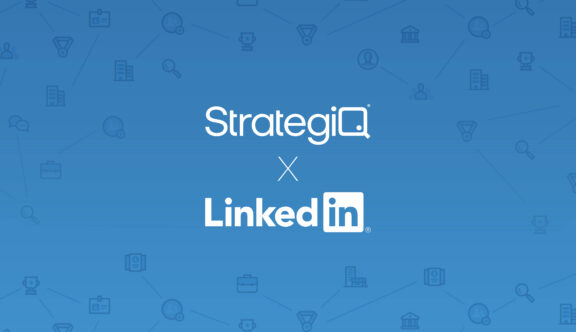We’re super-proud of Paid Media Manager Poppy Court, who took to the digital stage at the Third Annual Paid Search Association Conference to share her tips for leveraging LinkedIn advertising effectively. Here’s a full download of everything you need to know.
With 800M users worldwide and being home to around 57M companies and 65M key decision makers, LinkedIn is a key B2B marketing channel. But it’s not without its drawbacks.
Why? It’s expensive.
Average CPCs can range between £2.00 – £50 in some cases! LinkedIn understands the power of its B2B marketing potential and they’re not afraid to charge for this power!
This can often make it extremely hard for smaller B2B businesses to compete, as they simply don’t always have the budgets to support these higher cost levels.
Yes, the potential reward is huge but LinkedIn advertising often requires big budgets across a large period of time, when you consider the lead times across average B2B clients.
Not only this, the advertising platform is one of the worst out there!
It’s attempted to take its own stance on how paid accounts should be structured and it’s safe to say that it has failed. Its unfriendly user face can often be overwhelming and if you’re not careful you could fall into a number of traps to spend additional budget on functionality that you just don’t need.
So how should you get the best from LinkedIn?
Start with insights.
As always, you need to understand the business you’re working with. Here are some questions to guide you through this:
- What do they do? And how do they do it / sell it? Talking to both CMOs & CEOs and the sales team can be really insightful. What are the challenges that their customers are facing and how can your client’s product help to solve this?
- Why would someone be a client? Does your client’s product / service have a unique USP? How does the price of their product compare to the rest of the market?
- When would someone use it? Again, linking back to the problems that the product solves.
Establish business goals:
In most cases this will always lead back to revenue, but what underpins this revenue generation? Is it driving leads into the business? Is your client looking for a round of funding in order to grow the business? Or are they looking to sell their business to other organisations?
Is customer retention key? Do you need to do more to get the brand name out to users? Do you need to increase dwell time on your client’s website.
Whatever it is, having a clear understanding of how your role fits into the wider business objectives is key. This will allow you to build a strategy and set of KPIs that you know are contributing to the wider business objectives of your client.
Land on a one-liner to hinge on.
From here, you should be able to put a really well structured one liner to clearly state what your client is wanting to achieve.
For example:
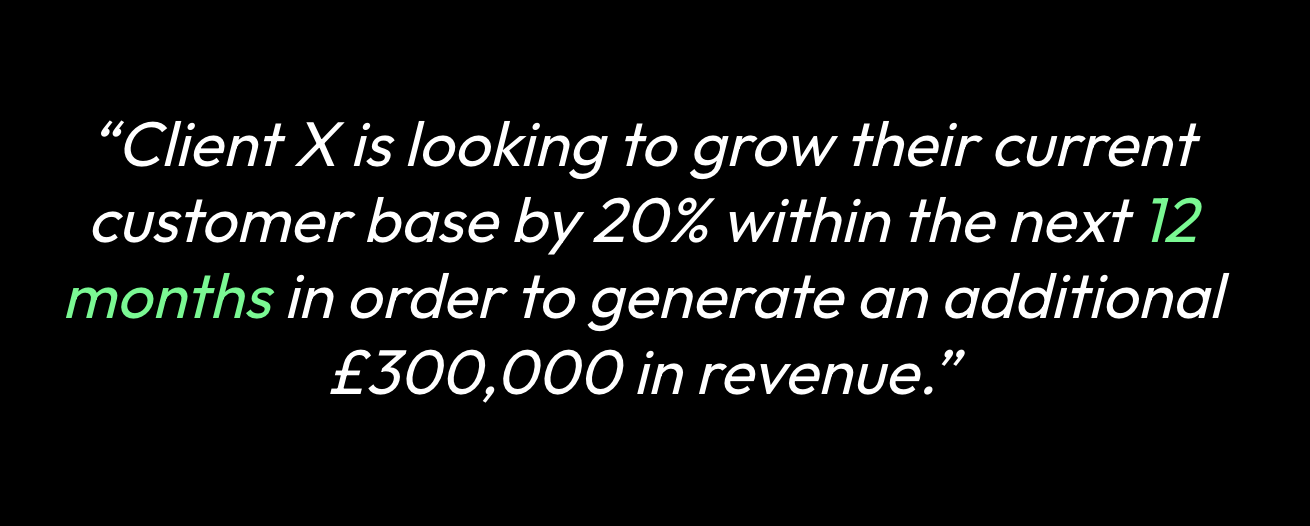
1. Nail those personas.
Your client may already have information on their target personas, but if not make sure you sit with them to build a better picture of who their ideal customer base is.
For B2B sectors, understand their job titles, the types of companies they work for, what positions do they hold in the business, the years of experience that they have and in some cases their level of education.
2. Market to humans.
Personality traits can also be key as it helps to shape your overall tone of voice. Do your audience appreciate high levels of detail or do they just want to know the top level basics.
How do they communicate with others? Do they prefer in person communication or do they prefer to keep social distance with others and prefer networking within online communities?
At this stage, it is really important to remember that just because its B2B doesn’t mean we’re not marketing to humans. At the end of the day, whether you’re doing B2C or B2B marketing, you will always be speaking to an individual. Look to serve your audiences with content that you feel users will be able to connect with on a human and personal level.
Research your target’s online behaviour
But not only do we want to establish the work life attributes of our clients, actually understanding the client’s online behaviour can be really insightful in understanding which channels and what type of content will resonate best with your audience.
For example, get to know what social channels they use. Are there any specific online publications that they regularly interact with? How much of their day-to-day do they spend online?
There are a variety of ways in which you can do this, but speaking to your client’s existing current customer base is a great way to get first hand feedback.
This is an example of a poll I recently put out on LinkedIn to find out what my network uses LinkedIn for:
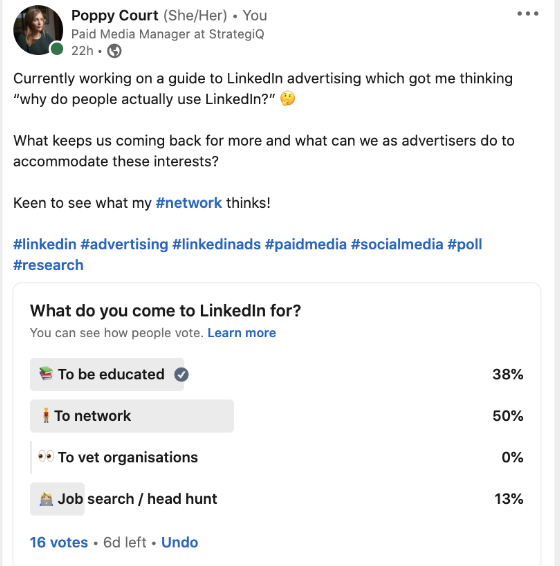
It may seem really simple but this can give you great insight into the types of content that will work best within your campaign.
Try to hang out in the spaces that your customer base does. This can give you a real clear understanding of how you can start to share your campaigns.
Tag up your site
In addition, the first step you should always take in planning out a LinkedIn campaign is to install the LinkedIn Insights tag to your site.
Even if you never run a LinkedIn campaign, just having this tag installed on your site can allow you to gather some great insights into the types of individuals that interact with your site including job functions, companies, industries and seniority.
Don’t forget Google Analytics
Google Analytics also shouldn’t be neglected at this stage.
Whilst it may not be able to provide you insight on the B2B attributes of your audience it can give some additional context on the types of people you should ideally be reaching in the form of age, gender and location.
Device can also be a powerful attribute to look into as it will allow you to assess the best type of assets to use and how to layout landing page content in order to make it easier for the user to engage with your campaign.
Have a healthy snoop
Also, take a look at what your competitors are up to. Use the Ads tab on their LinkedIn page to see what type of content they’re running. What assets are they using?
How has the copy been shaped? What are they asking their user base to do?
Where are users being directed to? What content does the page include?
Carry out a content audit
Spend some time establishing what type of content you feel your audience would best resonate with. From here, assess what content your client already has and can anything be repurposed for your marketing activity? Or do you need to create new content?
What current pages on your website have generated the highest number of pages / avg. time on page? Are there particular themes that you can pull on?
Also, have you got enough for testing purposes? For paid social especially, having a steady stream of content you can swap in and out is crucial for testing purposes.
Time for some strategy
Most importantly – link everything back to that single goal you identified earlier.
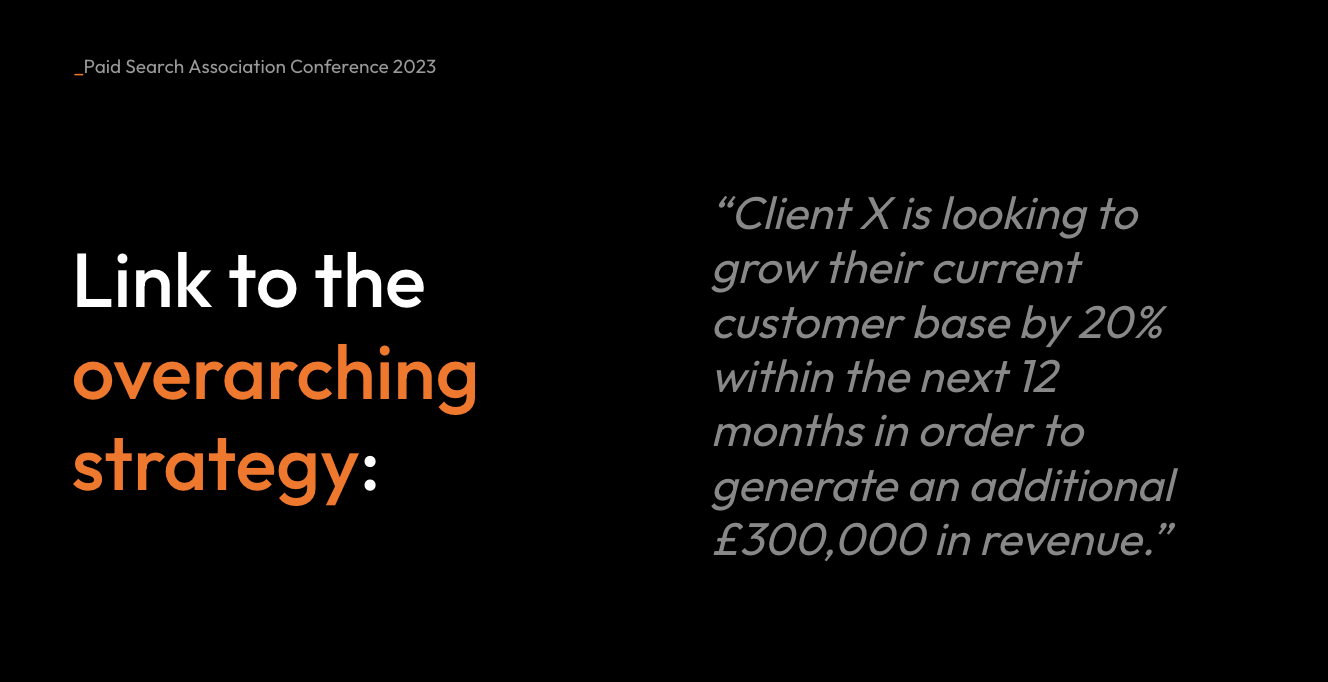
How does LinkedIn advertising support this? From here, you should be able to create a simple one liner as to how the channel will support in delivering this overall strategy.
It’s important at this stage to remember that LinkedIn is unlikely to be responsible for all stages of the marketing funnel. In my experience, LinkedIn is best used for driving awareness and consideration.
Driving direct conversions from it is extremely difficult due to the longer buying journeys with B2B sectors.
Once you’ve formalised how LinkedIn will support your strategy, clients love it when you’re up front with the KPIs you will measure the performance of your campaign, the targets you will hold yourself accountable for and again how these contribute to the overarching goals.
LinkedIn advertising and StrategiQ metric maps
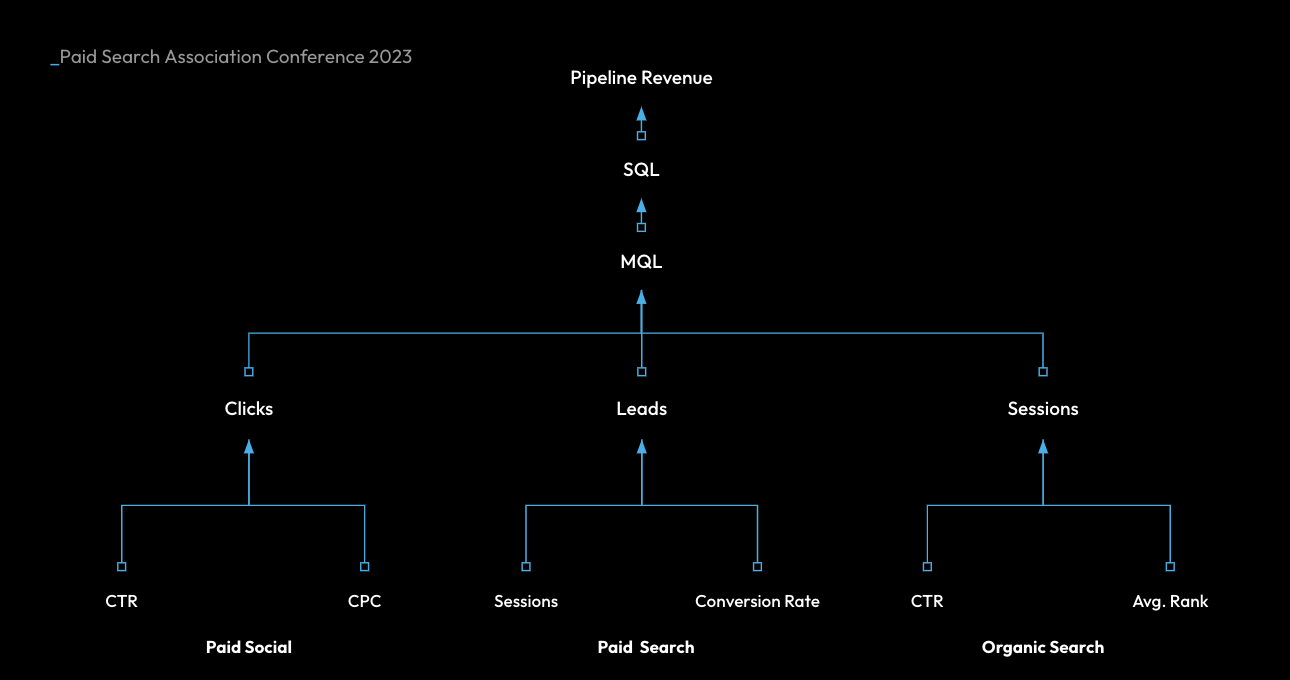
For every client at StrategiQ, we create what we call a metric map – a visual representation as to how each marketing channel influences the overall goal of the business.
For example, in order to generate the required pipeline revenue, how many SQLs need to be generated based on average lead to sale rate.
Broken down further, how many MQLs need to be produced based on the rate of sales qualification from the sales team.
And then from the MQLs that need to be generated, what is the value of each primary metric in order to achieve this based on things such as conversion rate and website visit frequency.
Once each channel has been given one primary metric that you will be held accountable for, you’ll then need to make sure you consider your supporting metrics. In the example of paid social for example, if clicks to your website is your primary metric, CTR and CPC levels will be key things to keep an eye on to make sure you can reach your click target.
Time to manage your campaign
Firstly, if you haven’t already done so create a LinkedIn specific DataStudio report.
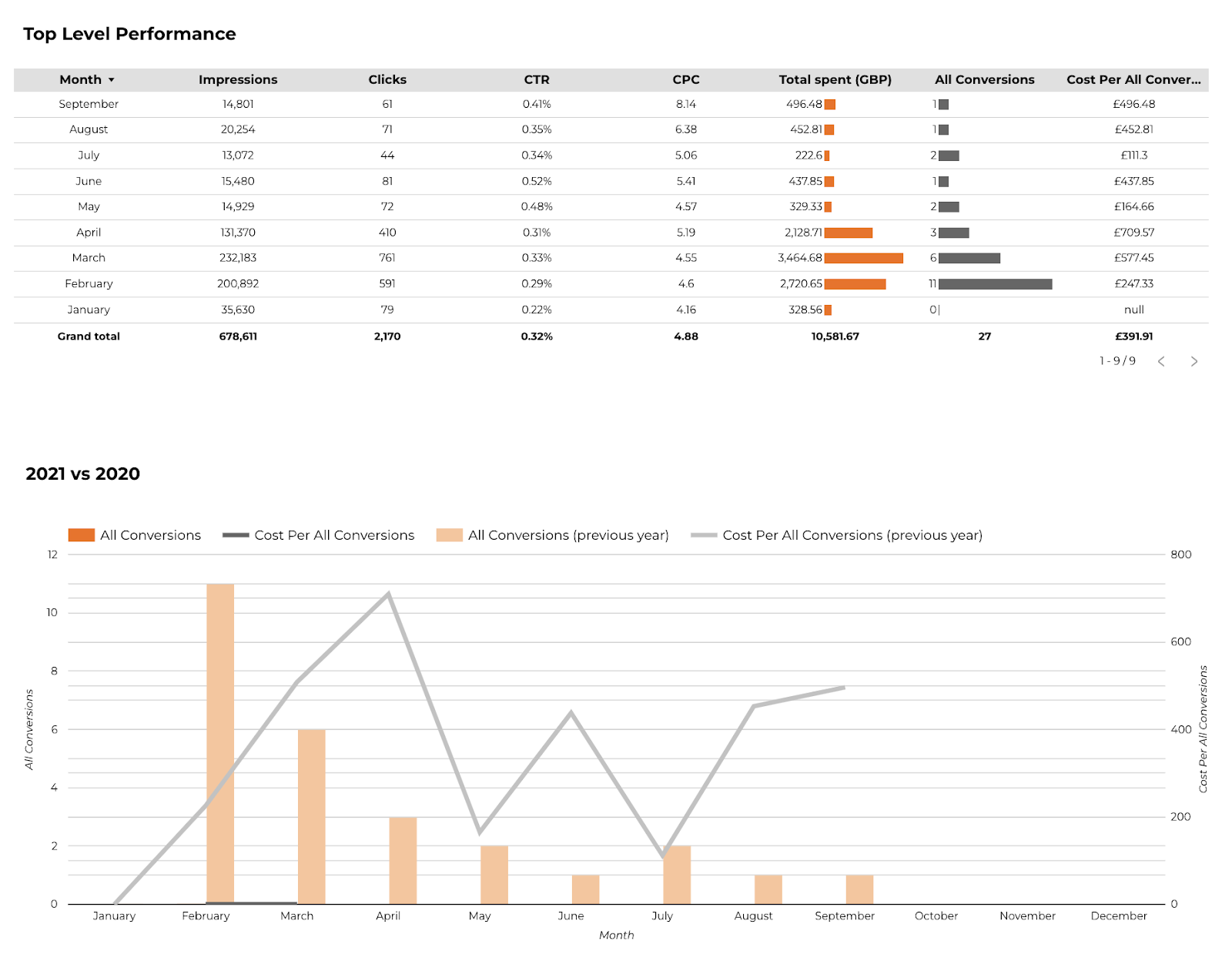
Whilst you can see performance metrics in LinkedIn itself, it’s not the most visually appealing platform and it can be quite hard to identify performance trends within the data.
You should also be keeping an eye on the demographic performance of your campaign.
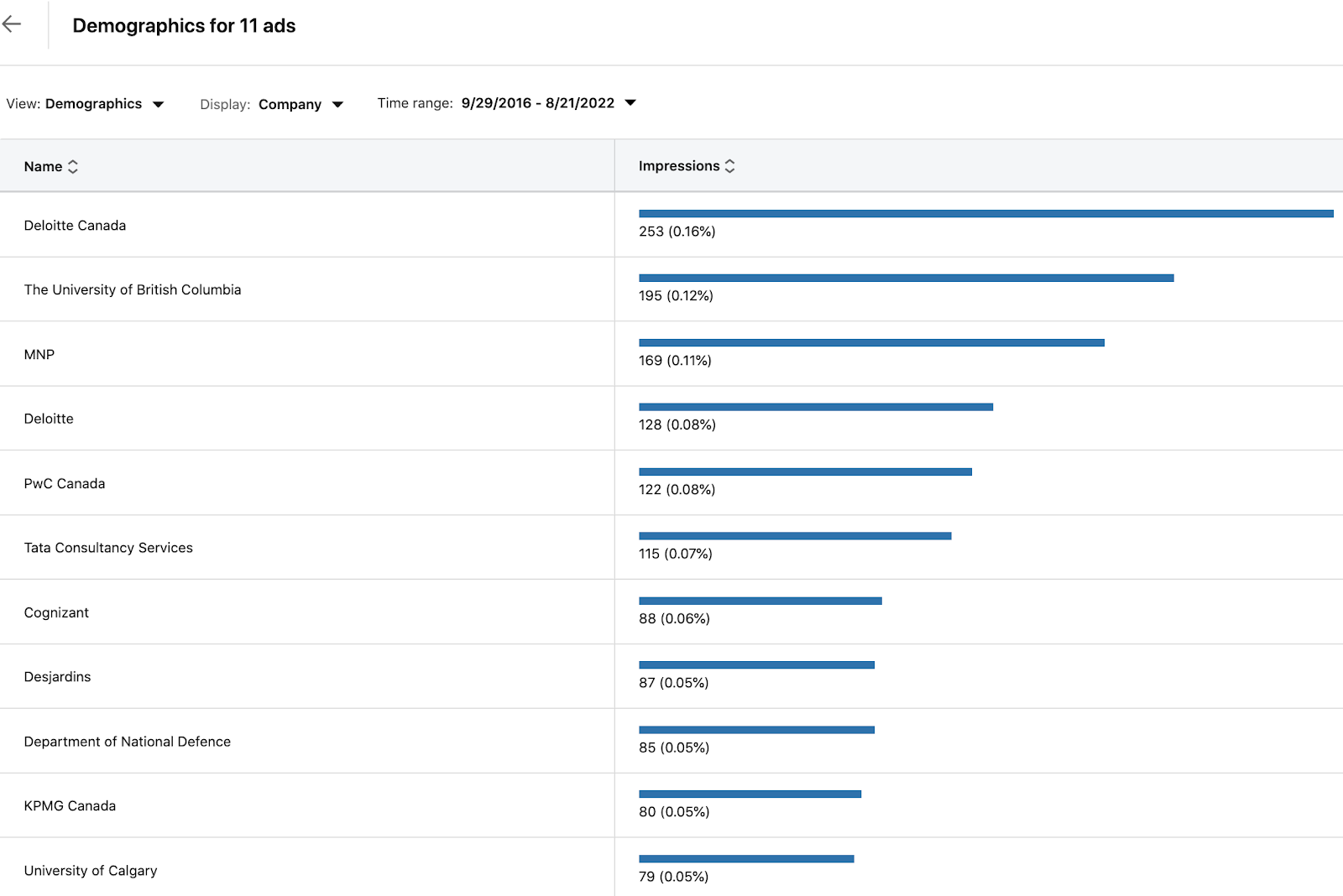
Again this can be done through DataStudio and can be a great way to both identify new potential target personas and areas where you need to start applying exclusions, for users that may be generating lower than average CTRs.
Keep an eye on Ad performance monitoring and adjustment
You should be keeping an eye on the click-through rates (CTRs) of your ads and assessing if there are any particular ad types that are generating higher than average CTRs.
Is there a common theme between the copy, asset types, CTAs?
Use these insights to then create new ad variants to ensure you’re pushing CTRs harder.
Keep an eye on audience engagement first hand by reviewing your ad comments.
Are your users creating conversation around the topic of your ad? What are they saying? Can we engage with them or provide them with additional content that they may find useful?
Use Google Analytics to measure any consideration based campaigns to see how your users are interacting with the landing page and inform consideration about your campaign’s performance in relation to behaviour on site.
HotJar is also another great way of visualising how users are interacting with your site.
Use the heat map functionality to see where users are more often clicking and use the recordings functionality to see if anything is causing a barrier to people converting.
And finally, Lead Forensics is a really insightful tool for B2B marketing.
Maximise your website visitor data
If you haven’t heard about Lead Forensics already, it is a platform that utilises company IP data to keep a log of the businesses that are visiting your website. It will not only provide an overview of the companies visiting, but it will also provide you insights on the pages they’re visiting and the frequency of their visits.
Plus, providing you have UTM tagged your campaigns correctly, it can also provide insights on which organisations have come directly from your campaigns.
Carry out honest but proactive weekly reporting
Putting together top level weekly performance updates gives clients confidence that you are continually looking for better performance.
Week on week comparisons also provide greater levels of context as to how the performance of your campaign is changing and make sure you’re benchmarking your performance against the targets that were set out at the start of the strategy.
In this update, provide clarity on the actions you’ve taken and what you will be doing the following week to further improve performance.
Also review…Each month and quarter
Monthly updates are where you can look at a whole month’s worth of data and measure against the KPIs.
Provide context on what we have achieved and why. If we haven’t achieved, why haven’t we and what will we do next month to resolve this?
Get a sense from the client as well on how overall business performance is going. LinkedIn advertising is just one part of the overall marketing strategy and can’t always be a true reflection of how the overall business is performing.
Quarterly reports are where you can provide more detail to your client on the learnings from the previous quarter and provide recommendations on how we can adapt the strategy going forwards.
Again, are we achieving the performance that was originally set in the forecast. Is the forecast still valid or do we need to tweak these to get a better understanding of what is working?
Assess the wider marketing insights. Have competitors drastically changed their advertising strategy and are there any wider industry insights that may have altered consumer behaviour (e.g. seasonality, the economy). Don’t forget to review the business priorities as a lot can change in three months.
And finally… Don’t cling on if it isn’t working
It is really important to remember that it is ok to disregard a marketing channel if it is not working.
If you have tried every possible avenue on the platform, it is important to be open and honest with your client and recommend that they put their effort elsewhere. Your client is much more likely to respond to you if you’re transparent in your thinking about how their budget could be better spent in areas that are more likely to deliver the overarching business goals.
Looking ahead at how you will manage your paid media activity in 2023? If so, we’d love to hear from you! Get in touch with us today to talk through your paid media strategy with a member of our Paid Media team.
